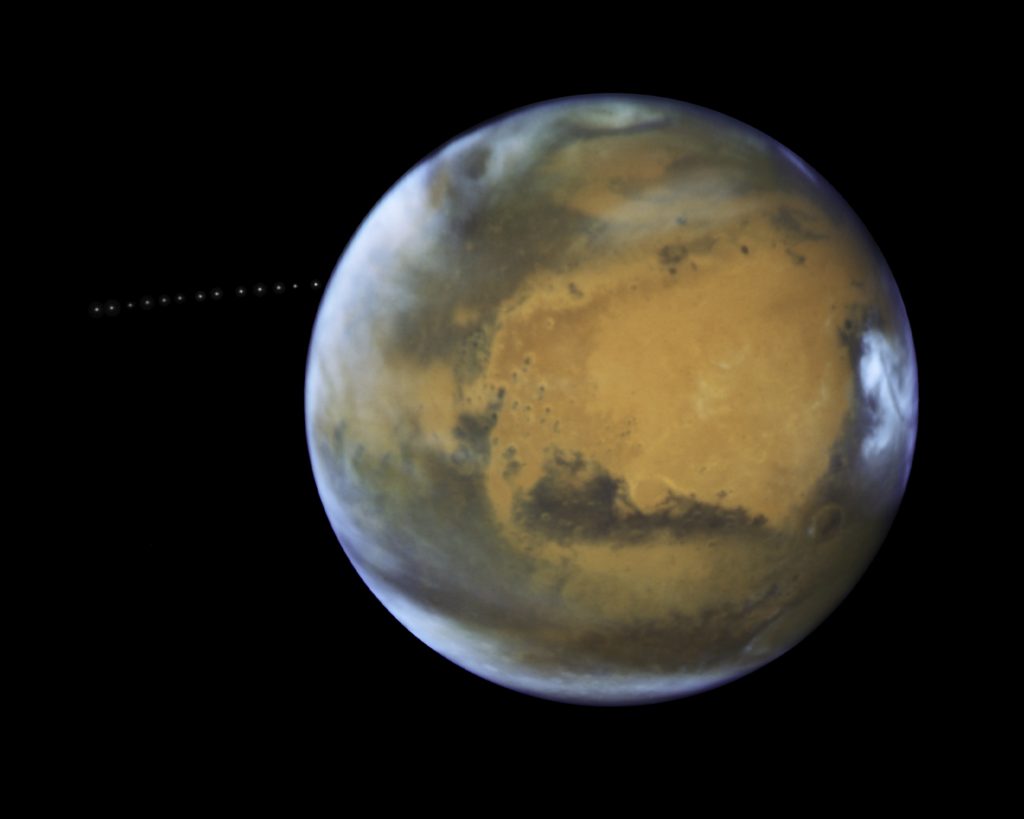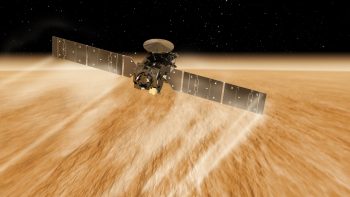Editor’s note: Today’s update comes from ESA’s Armelle Hubault, a spacecraft operations engineer working on the ExoMars/TGO team at ESOC. The news? ESA’s ExoMars/TGO orbiter – now conducting a year-long aerobraking campaign at Mars – crossed the orbit of Phobos today (spoiler alert: we avoided a collision!), marking a notable milestone in progress toward attaining its final, ca. 400-km altitude circular science orbit.
UPDATE 22:00 CET: See some explanatory charts sent in by the TGO flight dynamics team

Phobos seen by Hubble: While photographing Mars, The ESA/NASA Hubble Space Telescope captured a cameo appearance of the tiny moon Phobos on its trek around the Red Planet (click on image for full details). Credit: NASA/ESA/Z. Levay (STScI) – Acknowledgment: J. Bell (ASU) & M. Wolff (Space Science Institute)
Armelle wrote:
Here are the facts about the Phobos orbit crossing today.
The orbit crossing is not a Phobos flyby. In fact, we did our best to ensure that Phobos would be at the farthest possible point away from TGO when we cross the moon’s orbit. The moon will basically be on the other side of Mars when our spacecraft crosses its orbit [Editor: Phobos will be 9320 km from the centre of Mars for the first crossing].
This results in two crossings today: one around 14:30 UT and a second at 20:00 UT (15:30 and 21:00 CET, respectively). On each crossing of Phobos’ orbit, TGO will ‘miss’ the Phobos orbit by 23 km (and 120 minutes) and 10 km (and 200 minutes), respectively.

Visualisation of the ExoMars Trace Gas Orbiter aerobraking at Mars. With aerobraking, the spacecraft’s solar array experiences tiny amounts of drag owing to the wisps of martian atmosphere at very high altitudes, which slows the craft and lowers its orbit. Credit: ESA/ATG medialab
Note that the diameter of Phobos is about 20 km, so these passes by the orbit are very, very close!
Over the last few days, we adapted the phase of our orbit to ensure maximum ‘outphasing’ of Phobos and TGO, so today there is actually nothing for the flight control team to do but watch and monitor.
The crossing is taking place around apocentre (point of farthest approach to Mars); remember that our pericentre (point of closest approach) remains on the order of 100 km from the martian surface, actually in the atmosphere, which is how we are obtaining the aerobraking effect.

Discussion: 2 comments
How much force (Newton) does the aerobraking apply?
Were there any opportunities to obtain any images of Phobos during the period of (or after) this exciting milestone assuming that a) Phobos became more in-phase as the weeks went on, and b) any cameras were on? Perhaps the spacecraft instruments will be switched on after the potentially damaging aerobraking stage thereby mooting my question?